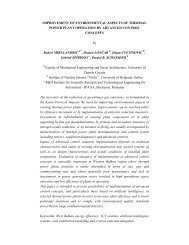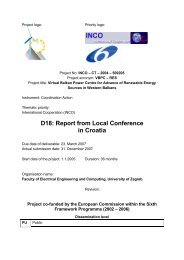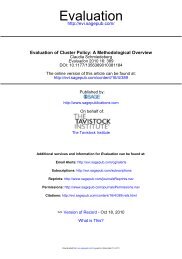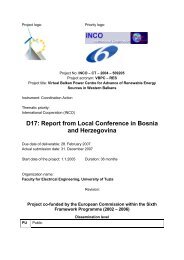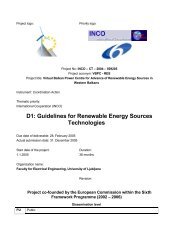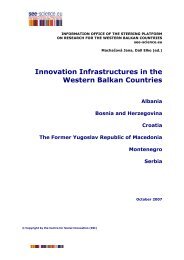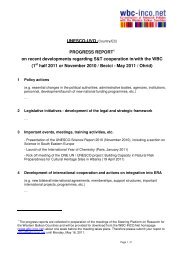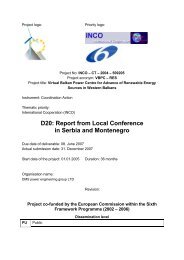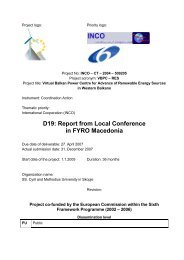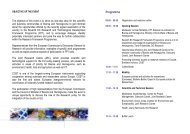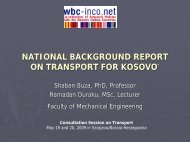Prva stran - WBC-INCO Net
Prva stran - WBC-INCO Net
Prva stran - WBC-INCO Net
Create successful ePaper yourself
Turn your PDF publications into a flip-book with our unique Google optimized e-Paper software.
additionally very welcomed in areas were grid-connections<br />
are discouraged due to nature-preservation policies or due to<br />
some specific environmental or some other reasons.<br />
Economic aspects: According to the local utility<br />
representatives, in the remote mountainous areas an average<br />
electricity distribution is 1.2 consumers per square<br />
kilometer, and there are hundreds of places similar to our<br />
selected case study. Hence, the conventional grid-connected<br />
energy source cannot be expected in the foreseeable future.<br />
On the other hand, the introduction of the RES in the these<br />
remote communities would result in the people returning to<br />
the region, re-starting agriculture, possibly eco-, and cattle<br />
breeding, and contribute to the increase in the overall living<br />
and economic conditions. In addition, the development of a<br />
successful sector of renewable energy sources could in the<br />
long run contribute to diversification of energy production,<br />
decreased import of energy and significant reduction of the<br />
pollution from the energy sector. Furthermore, employment<br />
and all associated issues are today one of imperatives of the<br />
Croatian economic and social policy. Using RES provides<br />
new jobs openings, investment in rural areas, and retention<br />
of the income within local communities.<br />
Social aspects: Migration to the neighboring cities or<br />
even abroad is the reality of the places like Busevic, which<br />
is especially the case with the younger population.<br />
However, the inhabitants in the visited households stated<br />
that if they would gain electricity, the other members of<br />
their family would return to live there. Hence, these cases<br />
are good examples how the introduction of electricity could<br />
help stop the depopulation. Not to underrate the fact that<br />
this RES incorporation would “spread news” to the<br />
neighboring communities and contribute to their<br />
environmental education. However, presently the level of<br />
knowledge, technological and practical, is quite low and an<br />
important part of the undertaking should concern the<br />
education as well. Only then, the wider introduction of RES<br />
and possible engagement of nearby local SME could be<br />
expected. Local administration seems to be very interested<br />
and eager to do, at local level, whatever is needed to help<br />
the realization of such projects.<br />
VI. CONCLUSIONS<br />
In this paper we have analyzed the potential for wider<br />
application of photovoltaics for electricity production in<br />
mountainous locations in Croatia. Being sparsely populated<br />
and with many houses/small communities distant from the<br />
grid lines these areas are good candidates for such<br />
application despite high prices of PV modules. The<br />
performance and costs of a small PV off-grid system is<br />
analyzed by detailed and realistic computer simulations. It<br />
has been found that, by using existing subsidies and<br />
incentives for RES offered to these areas (up to 80% off<br />
from commercial prices), the cost of a PV system for local<br />
communities should be below than 1600 € per 1 kWp,<br />
which would mean price of electricity of about 0.32 €/kWh<br />
during the warranty lifetime of PV modules (20 y).<br />
Satisfying basic needs for electricity by PV would open new<br />
opportunities for sustainable socio-economic development<br />
in isolated rural regions of Croatia.<br />
Acknowledgements: This research was supported by the<br />
EU FP6 project RISE-<strong>INCO</strong>-CT-204-509161, and Ministry<br />
of Science and Technology of Croatia. Authors would like<br />
to thank A. Pavic, R. Oreskovic and N. Pavlus for providing<br />
and M. Ferk for collecting some of the data used in this<br />
paper.<br />
VII. REFERENCES<br />
[1] Statistički Godišnjak (Statistical Information) 2005, Zagreb, Croatia,<br />
published by Central Bureau of Statistics of the Republic of Croatia,<br />
Zagreb, Ilica 3. Editor: J. Gelo, ISBN 1330 335X.<br />
[2] Strategija prostornog razvitka RH (Strategy of teritorial development<br />
of Republic of Croatia), Ministry of environmental protection,<br />
phisical planning, and consruction, Republic of Croatia , Department<br />
for territorial planning, Zagreb, Republike Austrije 20, Croatia<br />
(http://www.mzopu.hr/default.aspx?id=3662)<br />
[3] J. Schmid, "Minigrids for rural development and economic growth,"<br />
Renewable Energy World, pp. 192-197, July-August. 2003.<br />
[4] Global Meteorological Database for Solar Energy and Applied<br />
Meteorology, www.meteonorm.ch<br />
[5] PVSYST, software package for the study, sizing, simulation and data<br />
analysis of complete PV systems, University Geneva,<br />
www.pvsyst.com<br />
[6] RETScreen International Clean Energy Project Analysis Software,<br />
http://www.retscreen.net<br />
[7] Zakon o područjima posebne državne skrbi (Law about regions of<br />
special govermental care ), Narodne novine (Official gazette) No.<br />
26/03 ,<br />
[8] Hrvatska Banka za Obnovu i Razvitak (Croatian Bank for Rebuilding<br />
and Development (HBOR), http://www.hbor.hr/; specifically<br />
http://www.hbor.hr/kre_programi_080.asp<br />
Uros V. Desnica was born in Islam Grcki, Croatia, on July 25, 1944. He<br />
graduated from the University of Zagreb. From 1968 with R.Boskovic<br />
Institute, the largest scientific Institute in Croatia,. From y. 1993 in the<br />
highest scientific position, scientific adviser. Leader of numerous domestic<br />
and international projects, Ph.D. theses, etc. Presently also leader of WP4<br />
in RISE Project. List of his publications contains altogether more than 190<br />
items (from which about half are papers cited in Current Content Database).<br />
About 70 of entries are directly connected with the utilization of solar<br />
energy . FP6 expert evaluator. Co-founder (1979) and editor (1982-85) of<br />
the Journal "Sunceva energija" (Solar energy). Co-founder (2004) and a<br />
member of Governing board of NGO Center for renewable energy Sources<br />
– CERES.<br />
Dunja Desnica-Frankovic was born in Nova Gradiska, Croatia, on<br />
December 03, 1942. She graduated from the University of Zagreb, from<br />
which she also took her PhD degree. She has worked at the Faculty of<br />
Veterinary Medicine, Zagreb, University of Lowell, MA, USA, University<br />
of Konstanz, Germany. She is currently with R. Boskovic Institute as a<br />
senior scientist. Her main scientific interest concerns materials science,<br />
semiconductors physics, and nanosized materials. She has published a<br />
number of scientific papers, among them 60 CC papers.<br />
Mario Rakic was born in Zagreb, Croatia, on September 29, 1981. He is a<br />
student at the Faculty of natural Sciences and Mathematics at Zagreb<br />
University. He is involved in semi-conductors physics, along with the<br />
research in techniques. He has submitted 4 patents. At the moment he is a<br />
participant in RISE project at R. Boskovic Institute.<br />
6



